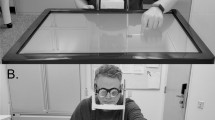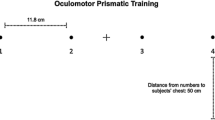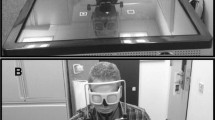Summary
The present study examined the kinematics of unrestricted reaches to prismaticallydisplaced targets. The kinematic analysis allowed us (1) to document how and where in the reach adjustments were made to compensate for the prismatic displacement, (2) to detail the changes that occur in the characteristics of reaches during the course of adaptation to the prisms, and (3) to look at the effects of providing information (or not) to the subject about the presence and nature of the prismatic distortion. The experiment differed from classic studies of prism adaptation in that subjects were permitted full visual feedback of their moving limb at all times, and entire reaching movements were recorded in addition to terminal errors. Experimental subjects were tested either with large-displacement prisms of the sort typically used in such experiments (20 diopters) or with small-displacement prisms (5 diopters) the properties of which went undetected in uninformed subjects. By using small displacements, it was possible to examine the process of visuomotor recalibration directly, free of contamination by “conscious” correction strategies. There were no differences in the terminal accuracies of the reaches made by subjects in any of the conditions. The availability of visual feedback allowed subjects to place their finger accurately on the target, despite the fact that in some cases their vision was displaced by as much as 11.4° to the right. When the entire reach was examined, however, it was found that the amount of curvature in the path increased when large or small diopter prisms were unexpectedly introduced, with the subjects showing large deviations to the right. This rightward deviation was corrected in the final approach with a larger terminal correction. On some occasions, nonetheless, corrections were observed very early in the course of the reaching movement and appeared to be part of a natural process of trajectory finetuning. Uninformed subjects exposed to either large or small prismatic displacements also showed evidence of adaptation through an increased number of on-line corrections which compensated for a tendency to reach into the side of space opposite to the direction of the displacement (a “negative aftereffect” in the path of the reach). Moreover, when questioned after the experiment, it became clear that uninformed subjects exposed to small prismatic displacements had apparently failed to detect any visual displacement whatsoever. Taken together, these results suggest that visuomotor recalibration can take place “automatically” without feedback from terminal errors and without the use of conscious strategies. In fact, making subjects aware of the distortion by providing them with explicit information about the prisms led to reduced levels of adaptation. These “informed” subjects showed more smoothly generated reaches during prism exposure, while post-exposure reaches showed less evidence of a negative aftereffect. In fact, postexposure reaches of subjects informed of the presence of the 5 diopter prismatic displacement were indistinguishable from reaches of control subjects.
Similar content being viewed by others
References
Abbs JH, Gracco VL, Cole KJ (1984) Control of movement coordination: sensorimotor mechanisms in speech motor programming. J Mot Behav 16: 195–231
Adams JA (1977) Feedback theory of how joint receptors regulate the timing and positioning of the limb. Psychol Rev 84: 504–523
Atkeson CG, Hollerbach JM (1985) Kinematic features of unrestrained vertical arm movements. J Neurosci 5: 2318–2330
Beaubaton D, Hay L (1982) Integration of visual cues in rapid goal-directed movements. Behav Brain Sci 5: 92–3
Beggs WDA, Howarth CI (1970) Movement control in repetitive motor task. Nature 225: 752–753
Canon LK (1970) Intermodality inconsistency of input and directed attention as determinants of the nature of adaptation. J Exp Psychol 84: 141–147
Canon LK (1971) Directed attention and maladaptive “adaptation” to displacement of the visual field. J Exp Psychol 88: 403–408
Carlton LG (1981) Processing visual feedback information for movement control. J Exp Psychol (Human Percept) 7: 1019–1030
Carlton LG, Carlton MJ (1987) Response amendment latencies during discrete arm movements. J Mot Behav 19: 227–239
Crossman ERFW, Goodeve PJ (1963) Feedback control of hand-movement and Fitts' law. J Exp Psychol 1983, 35A: 251–278
Efstathiou E (1969) Effects of exposure time and magnitude of prism transform on eye-hand coordination. J Exp Psychol 81: 235–240
Elliott D, Allard F (1985) The utilization of visual feedback information during rapid pointing movements. Quarterly J Exp Psychol: Human Exp Psychol 37A: 407–425
Glencross DJ (1977) Control of skilled movements. Psychol Bull 84: 14–29
Goodale MA, Pelisson D, Prablanc C (1986) Large adjustments in visually guided reaching do not depend on vision of the hand or perception of target displacement. Nature 320: 748–750
Hay L (1979) Spatial-temporal analysis of movements in children: motor programs versus feedback in the development of reaching. J Mot Behav 11: 189–200
Hay L, Beaubaton D (1986) Visual correction of a rapid goaldirected response. Percept Motor Skills 62: 51–57
Holst E von (1954) Relations between the central nervous system and the peripheral organs. Br J Animal Behav 2: 89–94
Jeannerod M, Biguer B (1987) The directional coding of reaching movements: a visuomotor conception of spatial neglect. In: M Jeannerod (ed) Neurophysiological and neuropsychological aspects of spatial neglect. North Holland, New York
Keele SW, Posner MI (1968) Processing of visual feedback in rapid movements. J Exp Psychol 77: 155–158
Kornheiser AS (1976) Adaptation to laterally displaced vision: a review. Psychol Bull 83: 783–816
Lacquaniti F, Soechting JF (1982) Coordination of arm and wrist motion during a reaching task. J Neurosci 2: 399–408
Liddell EGT, Sherrington C (1924) Reflexes in response to stretch (myotatic reflexes) Proc R Soc 96B: 212–242
McDonnell PM (1975) The development of visually guided reaching. Percept Psychophys 18: 181–185
Milner AD, Goodale MA (1988) Evidence for misdirected reaching to ‘places’ but not ‘targets’ in patients with righthemisphere lesions. Neuroscience Abstr 14: 219
Morasso P (1981) Spatial control of arm movements. Exp Brain Res 42: 223–227
Paillard J (1982) The contribution of peripheral and central vision to visually guided reaching. In: DJ Ingle, MA Goodale, RJW Mansfield (eds) Analysis of visual behavior. MIT Press, Cambridge, Mass
Paillard J, Jordan P, Brouchon M (1981) Visual motion cues in prismatic adaptation: evidence of two separate and additive processes. Acta Psychol 48: 253–270
Perenin MT, Vighetto A (1983) Optic ataxia: a specific disorder in visuomotor coordination. In: A Hein, M Jeannerod (eds) Spatially oriented behavior. Springer, New York
Quinn JT, Sherwood DE (1983) Timing requirements of changes in programs and parameter variables in rapid ongoing movements. J Mot Behav 15: 163–178
Ratcliff G, Davies-Jones GAE (1972) Defective visual localization in focal brain wounds. Brain 95: 46–60
Redding GM, Clark SE, Wallace B (1985) Attention and prism adaptation. Cogn Psychol 17: 1–25
Smith WM, Bowen KF (1980) The effects of delayed and displaced visual feedback on motor control. J Mot Behav 12: 91–101
Soechting JF, Lacquaniti F (1981) Invariant characteristics of a pointing movement in man. J Neurosci 1: 710–720
Uhlarik JJ (1973) Role of cognitive factors on adaptation to prismatic displacement J Exp Psychol 98: 223–232
Wallace B, Fisher LE (1984) The roles of target and eye motion in the production of visual shift in prism adaptation. J Gen Psychol 110: 251–262
Welch RB (1974) Research on adaptation to rearranged vision: 1966–1974. Perception 3: 367–392
Zelaznik HN, Hawkins B, Kisselburgh L (1983) Rapid visual feedback processing in single-aiming movements. J Mot Behav 15: 217–236
Author information
Authors and Affiliations
Rights and permissions
About this article
Cite this article
Jakobson, L.S., Goodale, M.A. Trajectories of reaches to prismatically-displaced targets: evidence for “automatic” visuomotor recalibration. Exp Brain Res 78, 575–587 (1989). https://doi.org/10.1007/BF00230245
Received:
Accepted:
Issue Date:
DOI: https://doi.org/10.1007/BF00230245




